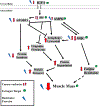Understanding sex differences in the regulation of cancer-induced muscle wasting
- PMID: 30102621
- PMCID: PMC6239206
- DOI: 10.1097/SPC.0000000000000380
Understanding sex differences in the regulation of cancer-induced muscle wasting
Abstract
Purpose of review: We highlight evidence for sexual dimorphism in preclinical and clinical studies investigating the cause and treatment of cancer cachexia.
Recent findings: Cancer cachexia is unintended bodyweight loss occurring with cancer, and skeletal muscle wasting is a critical predictor of negative outcomes in the cancer patient. Skeletal muscle exhibits sexual dimorphism in fiber type, function, and regeneration capacity. Sex differences have been implicated in skeletal muscle metabolism, mitochondrial function, immune response to injury, and myogenic stem cell regulation. All of these processes have the potential to be involved in cancer-induced muscle wasting. Unfortunately, the vast majority of published studies examining cancer cachexia in preclinical models or cancer patients either have not accounted for sex in their design or have exclusively studied males. Preclinical studies have established that ovarian function and estradiol can affect skeletal muscle function, metabolism and mass; ovarian function has also been implicated in the sensitivity of circulating inflammatory cytokines and the progression of cachexia.
Summary: Females and males have unique characteristics that effect skeletal muscle's microenvironment and intrinsic signaling. These differences provide a strong rationale for distinct causes for cancer cachexia development and treatment in males and females.
Conflict of interest statement
Figures
Similar articles
-
The emerging role of skeletal muscle oxidative metabolism as a biological target and cellular regulator of cancer-induced muscle wasting.Semin Cell Dev Biol. 2016 Jun;54:53-67. doi: 10.1016/j.semcdb.2015.11.005. Epub 2015 Dec 1. Semin Cell Dev Biol. 2016. PMID: 26593326 Free PMC article. Review.
-
High-Frequency Stimulation on Skeletal Muscle Maintenance in Female Cachectic Mice.Med Sci Sports Exerc. 2019 Sep;51(9):1828-1837. doi: 10.1249/MSS.0000000000001991. Med Sci Sports Exerc. 2019. PMID: 30933004 Free PMC article.
-
Mitochondrial plasticity in cancer-related muscle wasting: potential approaches for its management.Curr Opin Clin Nutr Metab Care. 2015 May;18(3):226-33. doi: 10.1097/MCO.0000000000000161. Curr Opin Clin Nutr Metab Care. 2015. PMID: 25783794 Review.
-
Sex Differences in Cancer Cachexia.Curr Osteoporos Rep. 2020 Dec;18(6):646-654. doi: 10.1007/s11914-020-00628-w. Epub 2020 Oct 12. Curr Osteoporos Rep. 2020. PMID: 33044689 Free PMC article. Review.
-
The mechanisms of cachexia underlying muscle dysfunction in COPD.J Appl Physiol (1985). 2013 May;114(9):1253-62. doi: 10.1152/japplphysiol.00790.2012. Epub 2012 Sep 27. J Appl Physiol (1985). 2013. PMID: 23019314 Review.
Cited by
-
Cancer cachexia in a mouse model of oxidative stress.J Cachexia Sarcopenia Muscle. 2020 Dec;11(6):1688-1704. doi: 10.1002/jcsm.12615. Epub 2020 Sep 12. J Cachexia Sarcopenia Muscle. 2020. PMID: 32918528 Free PMC article.
-
The Effect of Estradiol Administration on Muscle Mass Loss and Cachexia Progression in Female Apc Min/+ Mice.Front Endocrinol (Lausanne). 2019 Nov 1;10:720. doi: 10.3389/fendo.2019.00720. eCollection 2019. Front Endocrinol (Lausanne). 2019. PMID: 31736871 Free PMC article.
-
AnthropoAge, a novel approach to integrate body composition into the estimation of biological age.Aging Cell. 2023 Jan;22(1):e13756. doi: 10.1111/acel.13756. Epub 2022 Dec 22. Aging Cell. 2023. PMID: 36547004 Free PMC article.
-
Mechanisms of Estrogen Influence on Skeletal Muscle: Mass, Regeneration, and Mitochondrial Function.Sports Med. 2022 Dec;52(12):2853-2869. doi: 10.1007/s40279-022-01733-9. Epub 2022 Jul 30. Sports Med. 2022. PMID: 35907119 Review.
-
Sex-specific preservation of neuromuscular function and metabolism following systemic transplantation of multipotent adult stem cells in a murine model of progeria.Geroscience. 2024 Feb;46(1):1285-1302. doi: 10.1007/s11357-023-00892-5. Epub 2023 Aug 3. Geroscience. 2024. PMID: 37535205 Free PMC article.
References
-
- Fearon K, Strasser F, Anker SD, Bosaeus I, Bruera E, Fainsinger RL, et al. Definition and classification of cancer cachexia: an international consensus. Lancet Oncol. 2011;12(5):489–95. - PubMed
-
- Mattox TW. Cancer Cachexia: Cause, Diagnosis, and Treatment. Nutr Clin Pract. 2017;32(5):599–606. Treatment agents need to be personalized to each patient’s appetite, weight gain, quality of life, exposure to adverse effects, and the cost/ availability of the agent. - PubMed
-
- Anderson LJ, Liu H, Garcia JM. Sex Differences in Muscle Wasting. Adv Exp Med Biol. 2017;1043:153–97. This book chapter reviews estrogen’s mechanistic regulation on cachexia associated wasting, sarcopenia, and disuse; and its therapeutic role on reducing inflammation. - PubMed
-
- Vagnildhaug OM, Blum D, Wilcock A, Fayers P, Strasser F, Baracos VE, et al. The applicability of a weight loss grading system in cancer cachexia: a longitudinal analysis. J Cachexia Sarcopenia Muscle. 2017;8(5):789–97. A large study of men and women with weight loss helps observe rates of cachexia. - PMC - PubMed
-
- Chang KV, Chen JD, Wu WT, Huang KC, Hsu CT, Han DS. Association between Loss of Skeletal Muscle Mass and Mortality and Tumor Recurrence in Hepatocellular Carcinoma: A Systematic Review and Meta-Analysis. Liver Cancer. 2018;7(1):90–103. Skeletal muscle mass is inversely associated to all-cause mortality in patients with hepatocellular carcinoma. - PMC - PubMed
Publication types
MeSH terms
Substances
Grants and funding
LinkOut - more resources
Full Text Sources
Other Literature Sources
Research Materials



